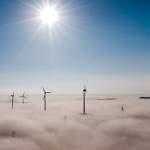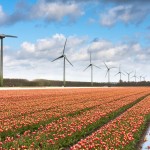
Kite-surfing off the coast of Brazil
The New Year will soon be upon us, and so will the new opportunities for wind power it could hold. With this in mind, Nigel Crowe from PMSS and Lead Session Chair at the EWEA Annual Event from 4-7 February, talks to us about wind power’s emerging markets outside Europe…
Where are the three most promising wind energy markets outside Europe – and why?
The first country with promising opportunities is Brazil – a dynamic high growth country which is starting to embrace renewables. And with the World Cup and Olympics coming up, the world’s attention will be focused on Brazil.
Then there’s China – the size of the country is enough to make it promising on its own, but if the challenges surrounding gaining access to the market and stimulating a global market place can be addressed the potential for European players is huge.
There is also the Middle East. Delivering renewables in a region so intrinsically locked into oil is also a challenge, but the rewards and potential are great.
continue reading »

Global Wind Day 2012 photo competition winner (c) EWEA/Markus Haslinge
Once again, a moribund global economy defined the year as politicians around the world tried to get ahead of the stubborn financial and debt crisis.
And yet, for the European wind industry, 2012 included a signature achievement when, in late September, it was announced that the EU had passed the milestone of 100 gigawatt (GW) of installed wind power capacity. This can generate enough electricity over a year to meet the total consumption of 57 million households, equivalent to the power production of 39 nuclear power plants.
The year was also significant for the European Wind Energy Association (EWEA) which celebrated its 30th anniversary of guiding the wind energy sector in its transition from an alternative to a mainstream power source.
EWEA also announced that Thomas Becker would become its new Chief Executive Officer when Christian Kjaer, after seven years in the top job, steps down early in 2013.
continue reading »
 Comments Off on Looking back – top blog stories of 2012
Comments Off on Looking back – top blog stories of 2012

Stephane Bourgeois, Head of Regulatory Affairs at EWEA
It had the potential to be a battle, but in the end renewable energy projects look set to receive the lion’s share of €1,500 million of EU funding set aside for renewables and carbon capture and storage (CCS).
At least €1,210 million of the total should go to 23 renewables projects, including six wind energy proposals, according to a draft decision submitted to the EU’s Climate Change Committee meeting on 13 December. Originally, most of the money was supposed to go to CCS projects, but most projects failed to secure the necessary permits or additional Member State funding.
continue reading »

Professor Gordon A. Hughes
The anti-wind energy Renewable Energy Foundation yesterday published an “anonymously peer reviewed” study by wind energy critic Professor Gordon Hughes (author of ‘The myth of green jobs’ and ‘Why wind energy is so expensive’) claiming that the economic life of wind turbines is 10-15 years rather than the 20-25 years stated by the wind industry.
Given that the author and publisher have a history of attacking wind energy and the fact that they do not say who peer-reviewed the study, perhaps one should not take the study too seriously. But that does not stop it being reported in the British media.
But at least some papers showed some scepticism. The Financial Times reported that the UK Department of Energy and Climate Change rejected Prof Hughes’ findings. “Our expectations of wind turbine lifetimes are based on rigorous analysis and evidence,” the department said. “Britain’s oldest commercial turbines at Delabole in Cornwall have only recently been replaced after 20 years of operation, and the technology has come on in leaps and bounds since that project started generating in 1991.”
continue reading »
 A new Danish survey on people living close to wind turbines shows that four out of five people feel there are no downsides to the experience – and 23 % of those surveyed became more positive towards the turbines within one year of installation. In addition, 59% of respondents answered “neither positive nor negative” to the question of whether their attitude changed over one year of living with the turbines in their midst.
A new Danish survey on people living close to wind turbines shows that four out of five people feel there are no downsides to the experience – and 23 % of those surveyed became more positive towards the turbines within one year of installation. In addition, 59% of respondents answered “neither positive nor negative” to the question of whether their attitude changed over one year of living with the turbines in their midst.
The nationwide analysis, carried out by an independent consultancy, was based on interviews with 1,278 people living within a radius of 2 kilometres (1.25 miles) of a wind turbine that was at least 120 metres (394 feet) tall and had been in operation for a year at minimum. This height meant that these were modern turbines, installed between 2002 and 2011. The people lived close to 125 turbines, spread over 30 different wind projects.
continue reading »












